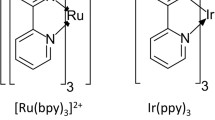Abstract
The electronic structure of the triphenylgallium molecule in the ground and electronically excited states has been calculated in the framework of the CNDO/S-CI method in sp and spd bases. The electron density in the AO's and atoms, the first ionization potential the energies and matrices of the changes in the electron density of the Sn and Tn states, the matrix elements of the spin-orbit coupling operator\(< S_i |\hat H_{SO} |T_j^\alpha > \) and\(< S_O |\hat H_{SO} |T_j^\alpha > \), the intensities and directions of polarization of the Sn → So and T2 → Tn transitions, and the phosphorescence lifetimes have been calculated. The following spectroscopic parametrization has been proposed for the Ga atom in the sp and spd bases: 1/2(Is + as) = 10.075 eV, 1/2(Ip + Ap) = 4.265 eV, 1/2(Id + Ad)=0, γ pGa =5 eV, γ dGa =O, β spGa =−7 eV, δ spdGa =−10 eV, and ξs,p,d=1.433. The influence of the d AO's on the shaping of the orbital nature of the S1 and T2 states has been analyzed.
Similar content being viewed by others
Literature cited
A. N. Rodionov, “Influence of the electronic structure of an atom of an elements on the structure, spectroscopic, and photochemical properties of heteroorganic compounds,” Author's abstract of dissertation for the degree of Doctor of Chemical Sciences, Moscow (1976).
V. A. Godik, G. G. Konoplev, A. N. Rodionov, and D. N. Shigorin, “Quantum-chemical investigation of the influence of the d AO's of a heteroatom on the luminescence-spectroscopic properties of fluorene derivations of group IV,” Teor. Éksp. Khim.,18, No. 1, 80–85 (1982).
V. A. Godik, S. N. Davydov, G. G. Konoplev, et al., “Quantum-chemical investigation of the orbital nature of the electronic states of polyatomic molecules. 2. Fluorene derivatives of nitrogen, phosphorus, arsenic, and antimony,” Zh. Fiz. Khim.,54, No. 12, 3001–3003 (1980).
V. A. Godik, “Órbital nature of vibronic states and luminescence-spectroscopic properties of heteroaromatic molecules,” Author's abstract of dissertation for the degree of Candidate of Physical and Mathematical Sciences, Moscow (1982).
D. N. Shigorin, “Systematics of molecules,” Zh. Fiz. Khim.,51, No. 8, 1894–1910 (1977).
J. Del Bene and H. H. Jaffe, “Use of the CNDO method in spectroscopy. 1. Benzene, pyridine, and diazines,” J. Chem. Phys.48, No. 4, 1807–1813 (1968).
K. Nishimoto and N. Mataga, “Electronic structure and spectra of some nitrogen heterocycles,” Zh. Phys. Chem.,12, No. 4, 335–338 (1955).
F. Zettler, H. D. Hansen, and H. Hess, “Die Kristall- und Molekulstructur des Triphenylborans,” J. Organomet. Chem.,72, No. 1, 157–162 (1974).
J. Hinze and H. H. Jaffe, “Electronegativity. 4. Orbital electronegativities of the neutral atoms of the periods 3A and 4A and of positive ions of periods 1 and 2,” J. Phys. Chem.,67, No. 7, 1501–1505 (1963).
G. Kuehnlenz and H. H. Jaffe, “The use of the CNDO method in spectroscopy. 8. Molecules containing boron, fluorine, and chlorine,” J. Chem. Phys.,58, No. 6, 2238–2243 (1973).
P. Carsky and S. Malek, “CNDO/S and INDO/S calculations on small aluminum compounds,” Collect. Czech. Chem. Comm.,42, No. 9, 2758–2766 (1977).
V. V. Voevodin, Computational Methods of Linear Algebra [in Russian], Nauka, Moscow (1977).
R. W. Bygelow and G. E. Johnson, “CNDO/S studies on the electronic structure of carbazole. 1. The parent molecule,” J. Chem. Phys.,66, No. 11, 4861–4871 (1977).
R. W. Bigelow, “CNDO/S assessment of the electronic structure of p-benzoquinone and tetrafluoro-p-benzoquinone,” J. Chem. Phys.,68, No. 11, 5086–5096 (1978).
A. N. Rodionov, V. K. Potapov, and K. L. Rogozhin, “Photoionization of some aromatic heteroorganic compounds,” Khim. Vys. Énerg.,7, No. 3, 278–279 (1973).
E. U. Condon and G. H. Shortley, “The Theory of Atomic Spectra, The university Press, Cambridge (1935).
B. F. Minaev, “Spin-orbit coupling in doublet states of molecules,” Opt. Spektrosk.,32, No. 1, 22–27 (1972).
Author information
Authors and Affiliations
Additional information
Translated from Teoreticheskaya i Éksperimental'naya Khimiya, Vol. 21, No. 5, pp. 584–590, September–October, 1985.
Rights and permissions
About this article
Cite this article
Godik, V.A., Rodionov, A.N. & Shigorin, D.N. Quantum-chemical investigation of the influence of the vacant orbitals of the heteroatom on the shaping of the electronically excited states and luminescence-spectroscopic properties of triphenylgallium. Theor Exp Chem 21, 557–562 (1985). https://doi.org/10.1007/BF00944091
Received:
Issue Date:
DOI: https://doi.org/10.1007/BF00944091



